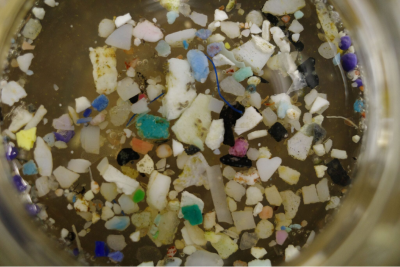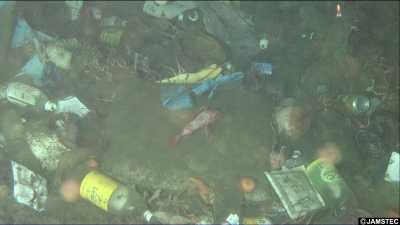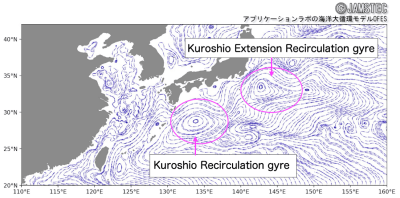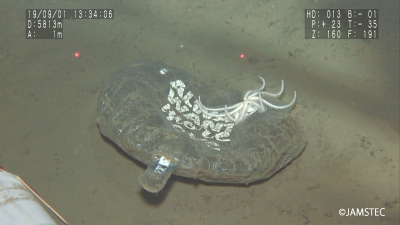Ryota Nakajima, Ph.D.
Marine plastic – The everlasting litter accumulating in the deep sea
Translation in English
Inexpensive and durable plastic products have improved our lives, but at the same time, the enormous amount of plastic litter flowing into the oceans is causing a serious environmental problem. Most plastics are not decomposed by microbes and remain in the ocean indefinitely, gradually filling the marine environment with plastic. Traces of plastic have been found in the deepest parts of the world, such as the Mariana Trench, as well as in the Arctic and Antarctic Oceans, leading to the conclusion that no ocean is free from plastic anymore. This article discusses the current and future state of marine plastic debris issues, incorporating the research results from the study team at the Japan Agency for Marine-Earth Science and Technology (JAMSTEC), to which I belong.
MASS PRODUCTION AND DISPOSAL
Approximately 400 million tons of plastic are produced worldwide each year, which is nearly equivalent to the total weight of humanity. Plastic mass production began in 1950, and the cumulative production amount by 2017 was approximately 9.2 billion tons. Over 7 billion tons of discarded plastics exceed, of which 10% has been recycled and 14% has been incinerated, while the majority of the remainder has been landfilled or released into the environment1. The rate at which recycled plastics are recycled again is only about 10%, indicating that the current recycling processes are not sustainable.
OVER 60% OF THE WORLD’S PLASTIC DEBRIS COMES FROM ASIA
Of the plastic debris found in the oceans, the vast majority, 80%, originates from land-based sources, mainly everyday disposable plastics that are carried to the sea by drainage and wind. The remaining 20% comes from marine activities such as fishing2. The estimated amount of plastic debris flowing from land to sea annually ranges from 500,000 tons to as much as 10 million tons3. If plastics were completely collected and processed, marine outflow could be prevented, but the problem lies with improperly managed plastic debris. This includes garbage left exposed, overflow from trash bins, and debris from illegal landfill sites. A portion of this “miss-managed plastic waste” eventually ends up in the sea. Every year, 60 to 99 million tons of such waste is generated worldwide, with more than 60% of it originating from Asia4. The outflow of plastics from land to sea is particularly noticeable after heavy rainfalls or the passage of typhoons or hurricanes. In Japan’s Sagami Bay, when plastics were observed immediately after a typhoon, plastics and wood debris that had flowed into the bay through rivers covered the entire sea surface. The amount of microplastics floating on the surface increased by 1,300 times compared to before the typhoon5. However, the large amount of plastic debris that flowed into the bay was quickly carried by ocean currents to the vast open ocean (Fig. 1).
THE MYSTERY OF MISSING PLASTICS
Various estimates exist for the total amount of plastics that have flowed into the ocean, ranging from 25 million to over 100 million tons6. However, the actual amount of plastic floating on the ocean surface is only about 10% of the total, which amounts to several hundred thousand to a few million tons7. The whereabouts of the remaining 90% of the plastic, referred to as “missing plastics,” are unknown, but most likely a large portion has sunk to the deep sea. Many people may imagine that plastic debris floats on the ocean surface, but it becomes heavier due to biological attachments like algae and barnacles and aggregation with particulate organic matters, ultimately sinking. For example, many bags used for food packaging initially float on water but eventually sink due to biological attachments. In the deep sea, depending on the location, a lot of food packaging can be seen (Fig. 2). Although a significant amount of plastic has not yet been found on the seabed to explain the missing plastics, the seabed near Japan’s coast is one of the most suspicious areas for plastic debris accumulation. The reasons for this are explained below.
JAPAN AS A HOTSPOT FOR MARINE PLASTIC
The waters around Japan are influenced by two major ocean currents: the Tsushima Warm Current, which flows northward through the Sea of Japan, and the Kuroshio Current, which flows northward through the Pacific Ocean. These currents bring a large amount of plastic debris from East Asia and Southeast Asia, making the concentration of microplastics in the waters near Japan high. Previous research indicates that the concentration of microplastics in the waters around Japan is 27 times the global average, suggesting that Japan’s seas are a focal point for plastic pollution8. A similar situation is likely observed in the deep sea.
It is anticipated that there are at least two significant deepsea garbage accumulation sites near Japan’s coast. The first is located on the seabed in the “Kuroshio Recirculation gyre” off the coast of Shikoku, and the second is in the “Kuroshio Extension Recirculation gyre” off the Boso Peninsula (Fig. 3). In the “Kuroshio Recirculation gyre” and the “Kuroshio Extension Recirculation gyre”, the surface currents are strong and swirl, causing the plastics brought from Japan, East Asia, and Southeast Asia to be caught in the gyres and accumulate. It is believed that the debris accumulated by the gyres is transported to the seabed, forming large deposits of debris on the deep seabed.
PLASTICS ACCUMULATING IN JAPAN’S DEEP SEA
Our research team first conducted a seabed survey in the “Kuroshio Extension Recirculation gyre”. This area is located 500 km away from the land, with depths exceeding 5,000 m. Using the manned submersible “Shinkai 6500,” we surveyed the seabed at depths of 5,700 to 5,800 m and found many single-use plastics (Figs. 4 and 5). Approximately 5,000 macro plastic debris (plastics with a diameter of 25 mm or more) were discovered per square kilometer9. This number is significantly higher than previously recognized. Although it was common knowledge that the number of plastic debris on the deep sea floor decreases the farther away from land, our findings contradict this notion. Moreover, the number of macro plastic debris found at similar depths in other areas of the North Pacific was two orders of magnitude higher.
Furthermore, when we examined the concentration of microplastics in the sediment on the deep seabed of the “Kuroshio Extension Recirculation gyre”, about 600 particles of microplastics per gram of sediment were confirmed10. This value is an order of magnitude higher than values near coastal deep seabeds and several times to thousands of times higher than the microplastic concentrations in the sediments of the Mediterranean and North Atlantic.
Simulations of flow fields using JAMSTEC’s supercomputer “Earth Simulator” revealed that the plastic debris seen on this region’s deep seabed did not come from far-off seabeds horizontally but directly sank from the plastic debris accumulated on the surface of this region11.
These studies, among others, are increasingly clarifying that the concentration of plastics on the deep seabed around Japan is very high compared to other marine areas. Most of the debris found on the deep seabed consists of single-use plastic products, such as plastic bags and food packaging. From the deep seabed of the “Kuroshio Extension Recirculation gyre”, food packaging manufactured in 1984, more than 35 years old at the time of collection, was found almost intact and with clear printing (Fig. 6). The deep sea has low temperatures and no ultraviolet light penetration, which are factors that prevent the degradation of plastics. Subsequent surveys have found debris such as food packaging manufactured in 1973 and 1984, and debris discarded half a century ago. Plastic that has settled in the deep sea continues to remain as “indestructible debris” on the seabed.
MICROPLASTICS ACCUMULATING IN THE MID-DEEP LAYERS
While the previous discussion was about the deep seabed, recent research has revealed that there are layers in the mid-deep sea where plastics accumulate. Studies on microplastics in the North Pacific have shown that a large amount of microplastics exists at a depth of 2,000 m in the mid-deep layers12. It has been found that particularly small microplastics, with diameters of several tens of micrometers, are accumulating in these mid-deep layers.
Microplastics existing on the sea surface gradually sink to the deep sea due to biological attachments, etc. However, during the sinking process, the organic material on their surface is consumed by microbes, and the factors that cause the plastics to sink are lost. At first glance, it might seem that these tiny particles would resurface, but they do not easily float back up, and more indigestible organic material remains on the surface of the plastics, continuing the state of neither floating nor sinking. As a result, layers of microplastics have been observed accumulating in the mid-deep layers of the sea. Since about 80% of marine plastics are composed of carbon, and the concentration of plastics in the sea continues to increase exponentially, such “accumulation zones” could potentially have a plastic carbon amount comparable to the organic carbon amount of biological systems, raising concerns about the impact on ecosystems and material cycles13.
PROBLEMS CAUSED BY PLASTICS
The plastic flowing into the oceans has various impacts on ecosystems and marine life. There are several problems caused by plastics, but here, the issue of plastic ingestion will be discussed. Humans do not intentionally eat plastic, and if they accidentally ingest small pieces of plastic, it is not digested and is excreted from the body. However, many marine organisms mistakenly ingest plastic as food. One factor is the smell of food attached to the plastic14. Some seabirds mistake plastic for food and feed it to their chicks. This results in plastic accumulating in the chicks’ stomachs, leading to intestinal blockage and death from malnutrition. In cases where large pieces of plastic are ingested, the digestive tract can also be physically damaged. In fish, it has been confirmed that over 60% of approximately 500 species examined retain microplastics in their bodies15. Small fish, such as sardines, swallow microplastics along with plankton when they engulf them. As the concentration of microplastics in seawater increases, it becomes impossible to avoid ingesting microplastics. Over 700 species of marine life have been found to ingest plastic16, and as the concentration of plastics in the ocean increases each year, the amount ingested by marine life is also expected to increase.
According to research teams in Japan, when the concentration of microplastics in the sea exceeds 1 gram per cubic meter, it has a significant adverse effect on marine life17. Especially in the surface layer of the North Pacific, it is predicted that this concentration could be exceeded in the 2060s, but the effects may appear even sooner on the seabed where the amount of plastic is greater. Additionally, the effects of toxic chemicals contained in plastics, such as additives, must also be considered. As described below, these chemicals can remain in the environment for a long time and have a wide-ranging impact.
TOXICITY OF PLASTIC ADDITIVES
Microplastics, due to their small size, are not digested and are excreted as feces, so the current concentration of microplastics does not pose a direct problem to organisms. However, the issue is not the toxicity of the plastic itself, but the harmful chemicals (additives) contained in the plastic. Some of these additives can have harmful effects on organisms. For example, polybrominated diphenyl ethers (PBDEs), which have been used to enhance the flame retardancy of plastics, were once widely used in electrical appliances and furniture. However, due to their persistence in the environment, bioaccumulation in organisms, long-distance mobility, and reproductive toxicity, PBDEs have been designated as Persistent Organic Pollutants (POPs) under the Stockholm Convention, and their use and manufacture have been banned. Similarly, plastic-related chemicals such as the UV-328 of benzotriazole UV stabilizers (BZT-UVs), hexabromocyclododecane (HBCD), and some perfluorinated compounds (PFOA) have recently been designated as POPs. These additives easily leach out of plastics, and when organisms ingest plastics, the digestive fluids extract the chemicals, which then move into the body and accumulate in fat. Organisms can accumulate these harmful chemicals in their bodies by directly or indirectly ingesting plastics containing them. In our study of plastic additives in the liver of deep-sea sharks living in Japan’s deep sea, high concentrations of PBDEs were detected in all eight species of deep-sea sharks captured18. Such harmful substances are particularly prevalent in organisms at the top of the food chain due to biomagnification. Similarly, a crustacean called the Hirondellea gigas isopod, collected from the hadal seabed more than 9,000 m deep, was found to contain the UV-328 of BZT-UVs19 (Fig. 7). These results indicate that chemical pollution from plastics extends to every corner of the deep sea.
PROPER HANDLING OF PLASTICS
Every day, a large amount of plastic flows from land to sea, and once it enters the ocean, recovery is nearly impossible. It is possible to collect drift debris from beaches and rivers, but this represents only a small part of the debris that flows into the sea. Since it is difficult to recover plastic debris that has already entered the sea, it is important to prevent new outflows of plastic. To achieve this, measures against “single-use plastics”, which are the most common in the ocean, are necessary. Many people think that active recycling can solve the problem. However, the current global plastic recycling rate is about 10%, and the rate at which recycled plastics are recycled again is also about 10%, meaning they are not perpetually recycled. Recycling is not a fundamental solution; reducing the amount of plastic used and cutting production is important. Especially, reducing “single-use plastics” is necessary, and a transition to alternative materials other than plastic is required for a sustainable future.
Biodegradable plastics, which decompose into water and carbon dioxide, are being developed to decompose in the ocean as well20. However, marine biodegradable plastics do not decompose immediately and could cause environmental problems similar to regular plastics in the long term. Therefore, the use of marine biodegradable plastics should be limited to specific applications with associated risks.
Awareness of measures against plastic pollution is increasing globally, and at the United Nations Environment Conference in March 2022, 175 countries and regions agreed to start preparing an international treaty aimed at resolving the plastic issue by 2025. I hope for significant positive changes in plastic production and use.
1 : R. Geyer, J. R. Jambeck, K. L. Law, Production, use, and fate of all plastics ever made. Science advances 3, e1700782 (2017).
2 : C. Morales-Caselles, J. Viejo, E. Martí, D. González-Fernández, H. Pragnell-Raasch, J. I. González-Gordillo, E. Montero, G. M. Arroyo, G. Hanke, V. S. Salvo, An inshore–offshore sorting system revealed from global classification of ocean litter. Nature Sustainability 4, 484-493 (2021).
3 : – J. R. Jambeck, R. Geyer, C. Wilcox, T. R. Siegler, M. Perryman, A. Andrady, R. Narayan, K. L. Law, Plastic debris inputs from land into the ocean. science 347, 768-771 (2015).
– L. J. Meijer, T. Van Emmerik, R. Van Der Ent, C. Schmidt, L. Lebreton, More than 1000 rivers account for 80% of global riverine plastic emissions into the ocean. Science advances 7, eaaz5803 (2021).
– M. L. Kaandorp, D. Lobelle, C. Kehl, H. A. Dijkstra, E. van Sebille, Global mass of buoyant marine plastics dominated by large long-lived debris. Nature Geoscience 16, 689-694 (2023).
4 : L. Lebreton, A. Andrady, Future scenarios of global plastic debris generation and disposal. Palgrave Communications 5, 1-11 (2019).
5 : R. Nakajima, T. Miyama, T. Kitahashi, N. Isobe, Y. Nagano, T. Ikuta, K. Oguri, M. Tsuchiya, T. Yoshida, K. Aoki, Plastic after an extreme storm: The typhoon-induced response of micro-and mesoplastics in coastal waters. Plastic Pollution in the Bay Areas, (2022).
6 : A. Isobe, S. Iwasaki, The fate of missing ocean plastics: Are they just a marine environmental problem? Science of the Total Environment 825, 153935 (2022).
7 : – M. L. Kaandorp, D. Lobelle, C. Kehl, H. A. Dijkstra, E. van Sebille, Global mass of buoyant marine plastic dominated by large long-lived debris. Nature Geoscience 16, 689-694 (2023).
– E. Van Sebille, C. Wilcox, L. Lebreton, N. Maximenko, B. D. Hardesty, J. A. Van Franeker, M. Eriksen, D. Siegel, F. Galgani, K. L. Law, A global inventory of small floating plastic debris. Environmental Research Letters 10, 124006 (2015).
8 : A. Isobe, K. Uchida, T. Tokai, S. Iwasaki, East Asian seas: a hot spot of pelagic microplastics. Marine pollution bulletin 101, 618-623 (2015).
9 : R. Nakajima, M. Tsuchiya, A. Yabuki, S. Masuda, T. Kitahashi, Y. Nagano, T. Ikuta, N. Isobe, Nakata, H. Ritchie, Massive occurrence of benthic plastic debris at the abyssal seafloor beneath the Kuroshio Extension, the North West Pacific. Marine Pollution Bulletin 166, 112188 (2021).
10 : M. Tsuchiya, T. Kitahashi, R. Nakajima, K. Oguri, K. Kawamura, A. Nakamura, K. Nakano, Maeda, M. Murayama, S. Chiba, Distribution of microplastics in bathyal-to hadal-depth sediments and transport process along the deep-sea canyon and the Kuroshio Extension in the Northwest Pacific. Marine Pollution Bulletin 199, 115466 (2024).
11 : R. Nakajima, M. Tsuchiya, A. Yabuki, S. Masuda, T. Kitahashi, Y. Nagano, T. Ikuta, N. Isobe, H. Nakata, H. Ritchie, Massive occurrence of benthic plastic debris at the abyssal seafloor beneath the Kuroshio Extension, the North West Pacific. Marine Pollution Bulletin 166, 112188 (2021).
12 : S. Zhao, T. J. Mincer, L. Lebreton, M. Egger, Pelagic microplastics in the North Pacific Subtropical Gyre: A prevalent anthropogenic component of the particulate organic carbon pool. PNAS nexus 2, pgad070 (2023).
13 : A. Stubbins, K. L. Law, S. E. Muñoz, T. S. Bianchi, L. Zhu, Plastics in the Earth system. Science 373, 51-55 (2021).
14 : M. S. Savoca, M. E. Wohlfeil, S. E. Ebeler, G. A. Nevitt, Marine plastic debris emits a keystone infochemical for olfactory foraging seabirds. Science advances 2, e1600395 (2016).
15 : A. Markic, J.-C. Gaertner, N. Gaertner-Mazouni, A. A. Koelmans, Plastic ingestion by marine fish in the wild. Critical Reviews in Environmental Science and Technology 50, 657-697 (2020).
16 : S. Kühn, J. A. Van Franeker, Quantitative overview of marine debris ingested by marine megafauna. Marine pollution bulletin 151, 110858 (2020).
17 : A. Isobe, S. Iwasaki, K. Uchida, T. Tokai, Abundance of non-conservative microplastics in the upper ocean from 1957 to 2066. Nature communications 10, 417 (2019).
18 : R. Nakajima, M. Kawato, Y. Fujiwara, S. Tsuchida, H. Ritchie, K. Fujikura, Occurrence and levels of polybrominated diphenyl ethers (PBDEs) in deep-sea sharks from Suruga Bay, Japan. Marine Pollution Bulletin 176, 113427 (2022).
19 : R. Nakajima, T. Ikuta, K. Oguri, H. Ritchie, Occurrence of polybrominated diphenyl ethers and benzotriazole UV stabilizers in the hadal amphipod Hirondellea gigas. iScience 26, (2023).
20 : T. Omura, N. Isobe, T. Miura, S. i. Ishii, M. Mori, Y. Ishitani, S. Kimura, K. Hidaka, K. Komiyama, M. Suzuki, Microbial decomposition of biodegradable plastics on the deep-sea floor. Nature Communications 15, 568 (2024).

©JAMSTEC
Fig. 1.
Microplastics collected with a neuston net in the sea
around Japan. Plastic pieces smaller than 5 mm are
refer- red to as microplastics. Currently, there are
more than 170 trillion microplastics floating on the
world’s ocean surface.

©JAMSTEC
Fig. 2.
Plastic litter accumulating on the seabed off the coast
of Northeast Japan (at a depth of 660m). Buoyant
plastics sink after becoming heavy due to the
attachment of algae and other organisms.

©JAMSTEC
Fig. 3.
Predicted areas of marine debris accumulation in the
Kuroshio Recirculation Gyre and the Kuroshio Extension
Recirculation Gyre near Japan.

©JAMSTEC
Fig. 4.
A plastic bag found on the seabed off the Boso
Peninsula, Japan (at a depth of 5814m). Packaging litter
such as bags is most common on the deep seabed.

©JAMSTEC
Fig. 5.
Balloon litter found on the seabed at a depth of
5813m. This is the deepest record for balloon litter in
the world.

©JAMSTEC
Fig. 6.
Food packaging collected from the seabed off the
Boso Peninsula (at a depth of 5707m). The print,
manufactured in 1984, is still readable (litter from 35
years ago). Plastics are not decomposed by
organisms, and it is believed to take hundreds to over
a thousand years to completely disintegrate.

©JAMSTEC
Fig. 7.
A crustacean, the Hirondellea gigas isopod, collected
from the seabed at a depth of 9200m off the Boso
Peninsula. Harmful chemicals used in plastics (UV
328) were detected inside its body.